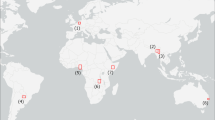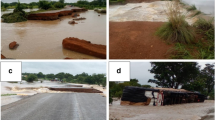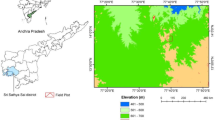Abstract
Flash floods have been the most frequent, extensive, and dangerous type of worldwide natural crisis. Mountainous, urbanized, and arid land areas like Tabuk region of Saudi Arabia are highly vulnerable to flooding due to heavy and sudden rainstorms that affected the people, infrastructures, and ecological and biophysical environment. Immediately following such a disaster event, advanced techniques are very essential to delineate and assess the damage resulted from successful rescue and relief operations. In this article, the European Space Agency (ESA) freely accessed images were conducted from the earth observation synthetic aperture radar (SAR) sensor, the images were successfully practiced to delineate the deadly flood crisis took place in Tabuk City in January 2019. The Sentinel Application Platform for Sentinel-1 Toolbox (S1TBX) is used to support the display and analysis of the large archive of products from the ESA SAR mission. Level-1 ground range detected with high resolution of 20 m × 22 m image at 2019/01/30 T15:39:44 acquired and processed. A backscatter value of − 22.39 dub is selected to separate water from everything else. Only region of interest mask pixels are considered for the histogram analysis. Accordingly, the maximum threshold error is set to 0.255. RGB map created a binary mask of flooded, and non-flooded pixels show that a significant part of the area was in danger. The findings of the current methodology quantify the flooded surface area by almost 9 km2 covers mainly the agricultural practices and the urban areas of the city of Tabuk. This study recommends that the future master plan of the Tabuk area should consider similar flooding risks. Finally, most arid lands like Tabuk are covered by sand that has similar backscatter as flooded land conditions. Therefore, the influence of this backscatter in flood mapping works should be assessed and exclusion techniques must be included to increase accuracy.









Similar content being viewed by others
References
Abdelkarim A, Gaber AF, Youssef AM, Pradhan B (2019) Flood hazard assessment of the urban area of Tabuk City, Kingdom of Saudi Arabia by integrating spatial-based hydrologic and hydrodynamic modeling. Sensors 19:1024
Aggarwal A (2016) Exposure, hazard and risk mapping during a flood event using open source geospatial technology. Geomat Nat Hazards Risk 7:1426–1441
Aldhebiani AY, Elhag M, Hegazy AK, Galal HK, Mufareh NS (2018) Consideration of NDVI thematic changes in density analysis and floristic composition of Wadi Yalamlam, Saudi Arabia. Geosci Instrumen Methods and Data Syst 7:297–306
Ali I, Cao S, Naeimi V, Paulik C, Wagner W (2018) Methods to remove the border noise from Sentinel-1 synthetic aperture radar data: implications and importance for time-series analysis. IEEE J Sel Top Appl Earth Obs Remote Sens 11:777–786
Ali I, Schuster C, Zebisch M, Förster M, Kleinschmit B, Notarnicola C (2013) First results of monitoring nature conservation sites in alpine region by using very high resolution (VHR) X-band SAR data. IEEE J Sel Top Appl Earth Obs Remote Sens 6:2265–2274
Bahrawi J, Elhag M (2019) Consideration of seasonal variations of water radiometric indices for the estimation of soil moisture content in arid environment in Aaudi Arabia. Appl Ecol Environ Res 17:285–303
Bahrawi JA, Elhag M, Aldhebiani AY, Galal HK, Hegazy AK, Alghailani E (2016) Soil erosion estimation using remote sensing techniques in Wadi Yalamlam Basin. Adv Mat Sci Eng, Saudi Arabia. https://doi.org/10.1155/2016/9585962
Carreño Conde F, De Mata Muñoz M (2019) Flood monitoring based on the study of Sentinel-1 SAR images: the Ebro river case study. Water 11:2454
Chuvieco E (2016) Fundamentals of satellite remote sensing: an environmental approach. CRC Press, Boca Raton
Cian F, Marconcini M, Ceccato P (2018) Normalized difference flood index for rapid flood mapping: taking advantage of EO big data. Remote Sens Environ 209:712–730
Das NN, Entekhabi D, Dunbar RS, Chaubell MJ, Colliander A, Yueh S, Jagdhuber T, Chen F, Crow W, O’neill PE (2019) The SMAP and copernicus Sentinel 1A/B microwave active-passive high resolution surface soil moisture product. Remote Sens Environ 233:111380
Dheenathayalan P, Small D, Schubert A, Hanssen RF (2016) High-precision positioning of radar scatterers. J Geod 90:403–422
El Shinnawy I, Bestawy A, Tahawy T (2017) Assessment and management of flash floods for sustainable development in Al-Sail Al Kabir area, Kingdom of Saudi Arabia. Int J Appl Eng Res 12:2807–2814
Elhag M (2016) Detection of temporal changes of eastern coast of Saudi Arabia for better natural resources management. Ind J Geo Mar Sci 45:29–37
Elhag M, Alshamsi D (2019) Integration of remote sensing and geographic information systems for geological fault detection on the island of Crete, Greece. Geosci Instrum Methods Data Syst 8:45–54
Elhag M, Bahrawi JA (2019) Sedimentation mapping in shallow shoreline of arid environments using active remote sensing data. Nat Hazards 99:879–894
Elhag M, Galal HK, Alsubaie H (2017) Understanding of morphometric features for adequate water resource management in arid environments. Geosci Instrum Methods Data Syst 6:293
Elkhrachy I (2015) Flash flood hazard mapping using satellite images and GIS tools: a case study of Najran City, Kingdom of Saudi Arabia (KSA). Egypt J Remote Sens Space Sci 18:261–278
Farina P, Colombo D, Fumagalli A, Marks F, Moretti S (2006) Permanent scatterers for landslide investigations: outcomes from the ESA-SLAM project. Eng Geol 88:200–217
Grimaldi S, Xu J, Li Y, Pauwels VR, Walker JP (2020) Flood mapping under vegetation using single SAR acquisitions. Remote Sens Environ 237:111582
Hakhoo N, Bhat GM, Pandita S, Hussain G, Haq AU, Hafiz M, Ahmed W, Singh Y, Thusu B (2019) Natural hazards-their drivers, mechanisms and impacts in the Shyok-Nubra Valley, NW Himalaya, India. Int J Disaster Risk Reduct 35:101094
Horritt M, Mason D, Cobby D, Davenport I, Bates P (2003) Waterline mapping in flooded vegetation from airborne SAR imagery. Remote Sens Environ 85:271–281
Horritt M, Mason D, Luckman A (2001) Flood boundary delineation from synthetic aperture radar imagery using a statistical active contour model. Int J Remote Sens 22:2489–2507
Hu M, Zhang X, Li Y, Yang H, Tanaka K (2019) Flood mitigation performance of low impact development technologies under different storms for retrofitting an urbanized area. J Clean Prod 222:373–380
Jha AK, Bloch R, Lamond J (2012) Cities and flooding: a guide to integrated urban flood risk management for the 21st century. The World Bank, Washington, DC
Lee J-S, Wen J-H, Ainsworth TL, Chen K-S, Chen AJ (2009) Improved sigma filter for speckle filtering of SAR imagery. IEEE Trans Geosci Remote Sens 47:202–213
Liu C, Li Y (2017) GIS-based dynamic modelling and analysis of flash floods considering land-use planning. Int J Geogr Inf Sci 31:481–498
Martinis S (2017) Improving flood mapping in arid areas using Sentinel-1 time series data. In: 2017 IEEE international geoscience and remote sensing symposium (IGARSS), pp 193–196
Matgen P, Schumann G, Henry J-B, Hoffmann L, Pfister L (2007) Integration of SAR-derived river inundation areas, high-precision topographic data and a river flow model toward near real-time flood management. Int J Appl Earth Obs Geoinf 9:247–263
Pulvirenti L, Pierdicca N, Chini M, Guerriero L (2011) An algorithm for operational flood mapping from synthetic aperture radar (SAR) data based on the fuzzy logic. Nat Hazard Earth Syst Sci 11:529–540
Rahman MT (2019) Applications of active remote sensing technologies for natural disaster damage assessments. In: Environmental information systems: concepts, methodologies, tools, and applications. IGI Global, pennsylvania, pp 1014–1025
Raspini F, Bardi F, Bianchini S, Ciampalini A, Del Ventisette C, Farina P, Ferrigno F, Solari L, Casagli N (2017) The contribution of satellite SAR-derived displacement measurements in landslide risk management practices. Nat Hazards 86:327–351
Saxena N, Rathore N (2013) A review on speckle noise filtering techniques for SAR images. Int J Adv Res Comput Sci Electron Eng (IJARCSEE) 2:243–247
Schlaffer S, Chini M, Giustarini L, Matgen P (2017) Probabilistic mapping of flood-induced backscatter changes in SAR time series. Int J Appl Earth Obs Geoinf 56:77–87
Ward PJ, De Moel H, Aerts J, Glade T (2011) How are flood risk estimates affected by the choice of return-periods? Nat Hazards Earth Syst Sci 11(12):3181–3195
Yang L, Smith J, Baeck ML, Morin E (2019) Flash flooding in arid/semiarid regions: climatological analyses of flood-producing storms in central Arizona during the North American monsoon. J Hydrometeorol 20:1449–1471
Youssef AM, Hegab MA (2019). Flood-hazard assessment modeling using multicriteria analysis and GIS: a case study—Ras Gharib area, Egypt. In: Spatial modeling in GIS and R for earth and environmental sciences. Elsevier, Amsterdam, pp 229–257
Youssef AM, Pradhan B, Sefry SA (2016a) Flash flood susceptibility assessment in Jeddah city (Kingdom of Saudi Arabia) using bivariate and multivariate statistical models. Environ Earth Sci 75:12
Youssef AM, Sefry SA, Pradhan B, Alfadail EA (2016b) Analysis on causes of flash flood in Jeddah city (Kingdom of Saudi Arabia) of 2009 and 2011 using multi-sensor remote sensing data and GIS. Geomat Nat Hazards Risk 7:1018–1042
Zhao J, Chini M, Matgen P, Hostache R, Pelich R, Wagner W (2019) An automatic SAR-based change detection method for generating large-scale flood data records: the UK as a test case. In: IGARSS 2019—2019 IEEE international geoscience and remote sensing symposium, pp 6138–6141
Acknowledgements
This project was funded by the Deanship of Scientific Research (DSR), King Abdulaziz University, Jeddah, under Grant No. (DF-087-155-1441). The authors, therefore, acknowledge with thanks, DSR technical, and financial support.
Author information
Authors and Affiliations
Corresponding author
Additional information
Publisher's Note
Springer Nature remains neutral with regard to jurisdictional claims in published maps and institutional affiliations.
Rights and permissions
About this article
Cite this article
Elhag, M., Abdurahman, S.G. Advanced remote sensing techniques in flash flood delineation in Tabuk City, Saudi Arabia. Nat Hazards 103, 3401–3413 (2020). https://doi.org/10.1007/s11069-020-04135-0
Received:
Accepted:
Published:
Issue Date:
DOI: https://doi.org/10.1007/s11069-020-04135-0




